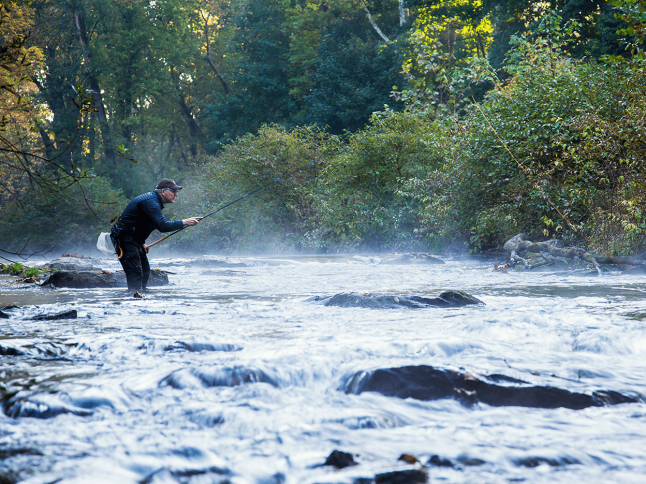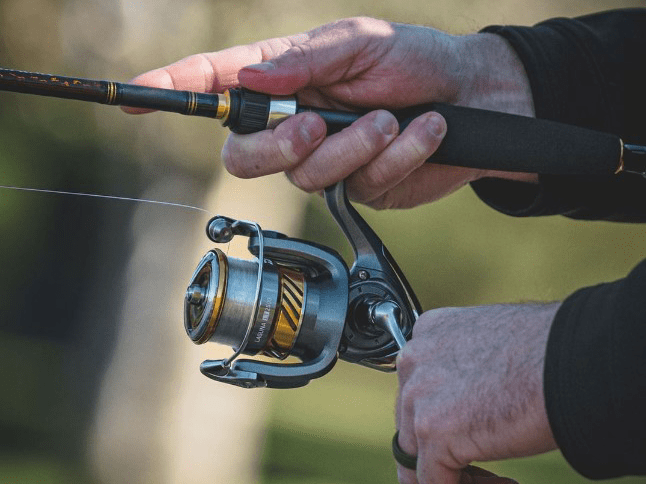Tenkara Fly Fishing
Guided Fishing Adventures
Tenkara Fly-Fishing

Tenkara fishing can be seen as a streamlined and simplified version of traditional fly fishing. The equipment is designed to direct focus on the actual fishing and catching of the fish, not to cause a major preoccupation with the equipment. Only a rod, line and fly are necessary for Tenkara fishing (no reel is used). The appeal of Tenkara is its elegant simplicity. There are also other advantages of using the long Tenkara rods when fishing in mountain streams, primarily the lightness of the line and delicate presentation. The long rod allows for precise placement of the fly on small pools and holds the fly in place on the other side of a current.
Conventional Tackle

If you have caught a fish in your lifetime, there’s a pretty high chance you caught it on a “conventional” fishing rod and reel. Conventional fishing is easily the most known way of fishing; from farm ponds to offshore, a conventional rod and reel can do it all. They come in several styles, from Mickey Mouse push button to giant long rods with electric reels on them; you just have to know what you’re setting out to catch to choose the right one for you. We are saying conventional to discuss the use of conventional lures and baits. Unlike fly fishing with flies, netting fish with cast nets, or spearfishing with a speargun, you’re using a standard fishing rod with one of a few standard reels such as push buttons, spinning reels, and bait-casters.
Guided Wade Trips
Trips are guided. Gear, waders, pole, rod, lures, flies or bait, snacks, expert guide included.
Feel the water surround you as you tiptoe, stalk, cast, hook and land some of the most beautiful fish in the world. Wade fishing allows you to immerse yourself in the experience – even starting to think like a fish!
Like all of our trip’s guides will provide you with the necessary knowledge, skills, and equipment to find success. Our fishing trips happen on Pennsylvania’s most famous fishing streams, including Big Spring, Letort, Yellow Breeches and the famous Susquehanna river. The actual fishing location is selected based on time of year, the weather and your skill and interest level. From beginner to advanced, everyone can learn and uncover new secrets. Please let us know if there’s a location you prefer prior to booking.
FAQ
To see fishing conditions, visit here
Trout species such as brook, brown, rainbow can be fished 365 days a year with the best hatches
occurring April through mid-June. With limestone spring creeks nearby, we always have good trout
fishing, even in mid-summer.
We fish for smallmouth bass in the spring, summer, and fall with the best topwater action in late summer.
We primarily fish for Rainbow Trout, Brown Trout, Brook Trout, Smallmouth Bass, and Sunfish. These species can be fished 365 days a year, but the best hatches occur from April through mid-June. We are fortunate to have nearby limestone spring creeks that offer good trout fishing even in mid-summer.
Yes, any person over the age of 16 needs to have a Pennsylvania fishing license in order to participate in Adventure Explorations fishing experiences.
To obtain a Pennsylvania fishing license, you can visit here. You may also buy one locally at TCO Fly Shop.
Fishing trips depend on the time of the year and the recent weather patterns. Our expert guides are skilled at determining the best fishing place possible for the current conditions.
Fly fishing is an angling method that uses a lightweight lure—called an artificial fly—to catch fish. The lightweight line requires casting techniques significantly different from other forms of casting.
If it’s Spring, Summer, or Fall, use layers to keep your body comfortable. If it’s winter, we’ll be using the same gear, but the same principle applies. Wear comfortable pants and a top that you can move easily in. Use a non-cotton base layer, preferably lightweight (cool days) or a layer made for whisking sweat and heat away. Wear eye protection and use Croakies to secure them. All wallets and phones get put into dry storage. Call for recommendations, if needed. Remember that wind adds windchill.

HQ - The Hotel Hershey, 100 Hotel Road, Outfitter Bldg,
Hershey, PA 17033
101 Front Street, Boiling Springs, PA 17007
Lancaster, now open
888-238-3975
info@adventureexplorations.com
Keep up with the latest! Join Our Newsletter.